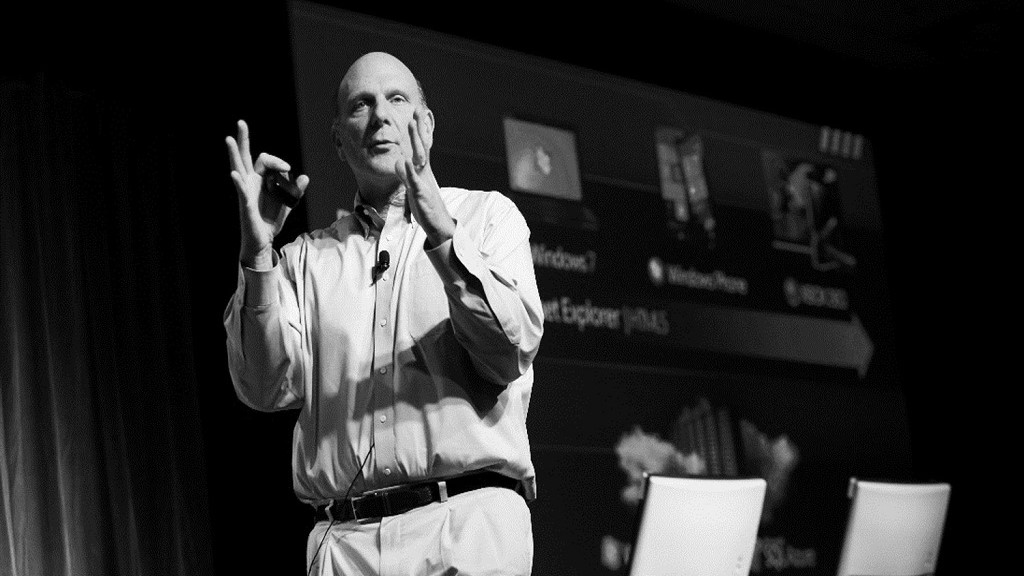Shoulders of Giants: Appreciating Steve (And Developers)
 Contributed by
Gina Romero
October 3, 2019
Contributed by
Gina Romero
October 3, 2019

If like me, you are a fan of Xbox 360 reminiscing about epic classic games like Gears of War, Halo and Rock Band, you will be grateful for Steve Ballmer’s contribution to Microsoft.
Stepping into the formidable shoes of Bill Gates is not a career move for the faint-hearted. This is why I have named this series: Shoulders of Giants, to pay tribute to those who first followed and then led.
Nowadays, when Steve Ballmer occupies the headlines of major news outlets, it’s because of his role as the owner of basketball team Los Angeles Clippers. In July 2019, he was seen in a press conference, expressing his enthusiasm about new players Kawhi Leonard and Paul George.
Journalists wrote about his iconic on-stage passion and exuberance, a trademark he’s been known for since his days in Microsoft. Most critics praise current CEO Satya Nadella’s bold moves to make the tech company relevant, with his acquisition of game Minecraft and even allowing the use of Microsoft software in Apple products. What most people forget, however, is that Ballmer paved the way for Nadella’s success.
Ballmer may not be everyone’s cup of tea but if there’s one thing that people can’t doubt him about — it’s his loyalty. His love affair with Microsoft started when he was 24 years old, a student of the MBA program of Stanford University. He saw an opportunity at the company of his Harvard classmate Bill Gates and decided that he should quit school and join this exciting new start-up. He even promised his parents that if things didn’t work out, he would go back to business school.
I’ve got four words “I LOVE THIS COMPANY!”
He was employee number 30 and his initial post was assistant to the president. Ballmer was offered a $50,000 base salary and a 5 to 10 percent equity in Microsoft and 10 percent of the profit growth he generated. That was in 1980 and it would take 18 more years in different executive positions before he was given the title of president in 1998 and eventually, CEO in 2000.
Throughout his career at Microsoft, he had never lost or wavered in his enthusiasm about the company. According to employees and journalists, Ballmer never lacked energy at company events or during interviews. He was described as having “the energy of a 5 year old” and in one event, he said the word “developer” fourteen times in a row to emphasize the importance of developers at Microsoft. His manic energy soon became his trademark and an undeniable proof of his loyalty.
Even when he left Microsoft in 2014, he held onto his 4 percent stake in the company, that continues to make him Microsoft’s largest individual shareholder.
“When I left, I still loved the company,” he told a journalist. “I did a little to diversify slightly, I put some money aside for charity, but I’m a loyal dude. I still drive Fords [a company where my father worked] and I still own Microsoft stock.”
Great companies in the way they work, start with great leaders
Ballmer had his share of both wins and losses during his tenure at Microsoft. In 1980, he played a crucial role in Microsoft’s negotiations with IBM, which then wanted to make computers available to more people.
However, other tech competitors soon emerged such as Google and Apple, rocking the steady place of IBM and Microsoft at the top. Critics were unforgiving that Microsoft missed on many opportunities such as search and social. For Ballmer, the flop of Windows Vista also weighed heavily on him. During these challenging times, insiders were even saying that Gates and Ballmer’s relationship turned sour.
When he was made CEO in 2000, however, Ballmer was able to lead Microsoft through some tough times. This includes the antitrust battle when Microsoft was being sued by the US federal government, about 40 US states and 30 countries due to patent and trust-related allegations. Ballmer felt the need to settle and move on despite causing the company billions of dollars. For Ballmer, it was better to settle and get it over with right away than suffer lingering suits that was bad for Microsoft’s image.
I’m proud of the fact that I made $250 billion under my watch as CEO
He also led Microsoft during the bursting of the dot-com bubble by growing the company. Most notably, he launched Xbox, acquired Skype, and built Microsoft’s $20 billion enterprise business.
While he remains a polarizing figure for both employees and outsiders alike, when all is said and done, Ballmer delivered results. During his time as CEO, Ballmer managed to triple Microsoft revenues and double its profits. In fact, revenues climbed to a record $18.53 billion in the first quarter of 2013. So it seemed like his energy was being directed at the right place and who could ever blame him for being excited about that?
The number one benefit of information technology is that it empowers people to do what they want to do. It lets people be creative. It lets people be productive. It lets people learn things they didn’t think they could learn before, and so in a sense, it is all about potential.
~Steve Ballmer
This article was originally published on Gina Romero’s LinkedIn and was republished with permission of the author.










Sorry, the comment form is closed at this time.